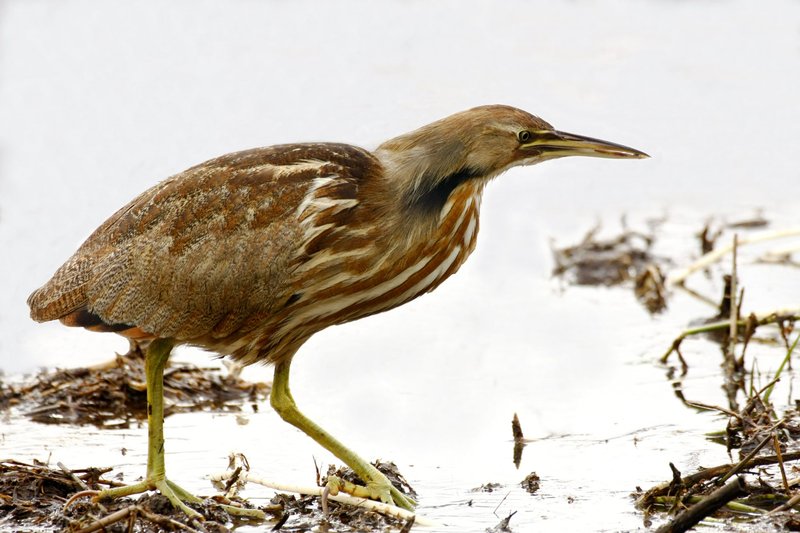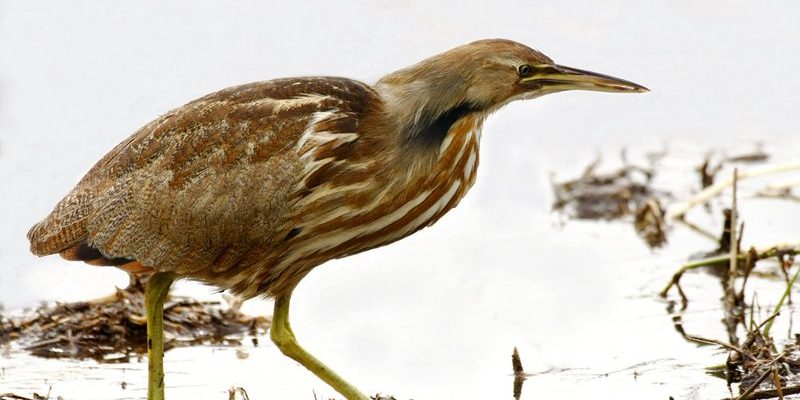
Imagine walking quietly through a marsh, where the air is thick with the scent of wet earth and the sounds of nature envelop you. Suddenly, a low, booming call echoes through the reeds, and you might wonder, “What creature makes that sound?” That’s a bittern—a secretive marsh bird known for its distinct calls and elusive nature.
Bitterns belong to the heron family, but they have their unique charm and quirks that set them apart. These fascinating birds are masters of camouflage, often blending seamlessly into their surroundings with their brown, streaked feathers. They’re not just ordinary birds; they’re a part of a complex ecosystem that thrives in wetland environments.
There are several species of bitterns, but the most common is the Great Bittern. Found across Europe and parts of Asia, these birds are a sight to behold—if you can spot them! Their elusive nature and impressive vocalizations make them a favorite among birdwatchers and nature enthusiasts alike.
Physical Characteristics of Bitterns
Bitterns are not only fascinating due to their behavior but also their appearance. They typically have a stocky build with long necks and legs, which help them navigate through their marshy habitats. The feathers of a bittern are beautifully patterned, usually featuring shades of brown, buff, and cream. This unique coloration helps them blend into the reeds and vegetation, making them hard to spot.
Adult bitterns can vary in size, with the Great Bittern being one of the largest, reaching lengths of up to 70 cm (about 27 inches). Their wingspan can stretch up to 1.5 meters (5 feet), allowing them to soar majestically when they take flight. You might notice that when they feel threatened, bitterns exhibit a remarkable behavior—they freeze and stand tall with their necks elongated, mimicking the reeds around them.
Their long bills are perfectly adapted for hunting. Bitterns primarily eat fish, amphibians, and small invertebrates. Using their sharp eyes, they can spot prey from a distance. When they’re ready to strike, they use a quick thrust of their bill to catch their meal, making them effective hunters in their watery domains.
Habitat Preferences
Bitterns thrive in wetland habitats, where they can find ample food and nesting sites. Think of marshes, swamps, and reed beds—places where water meets land, creating a rich tapestry of life. They prefer areas with dense vegetation, which provides the necessary cover to hide from predators and stalk their prey. These habitats are crucial for their survival and are often a sign of a healthy ecosystem.
The Great Bittern, in particular, is known for its preference for shallow water areas with tall reeds or sedges. They build their nests close to the water’s edge, where they feel safe and can easily access food. Unfortunately, due to habitat loss from development and drainage, many bittern populations are declining. Conservation efforts are crucial to protect these remarkable birds and their habitats.
You might be surprised to learn that bitterns are also migratory birds. Depending on the species, they might travel long distances between breeding and wintering grounds. For example, European bitterns often migrate to Africa during winter, searching for warmer climates and food availability. This migratory behavior adds another layer of intrigue to their life cycle.
Bittern Behavior and Vocalizations
One of the most fascinating aspects of bitterns is their vocalizations. Known for their deep, booming calls, male bitterns use these sounds to attract mates and establish territory. Their call can be heard up to several kilometers away, especially during the breeding season. It’s a sound that’s often described as a “booming” or “bellowing” noise, and once you hear it, you won’t forget it!
This vocalization is particularly important for males as they compete against one another for the attention of females. During courtship, the males perform a variety of displays, puffing out their chest and making their bodies appear larger. It’s almost like a dance, with calls echoing around the marsh. If you’re lucky enough to witness this, it’s a truly captivating experience.
In terms of daily activities, bitterns are mostly solitary birds, preferring to hunt and feed alone. They are mostly active at dawn and dusk, making them crepuscular creatures. During the day, they can often be found hidden among the reeds, resting or camouflaged from potential threats. Their stealthy nature is a strategy that has served them well in the wild.
Feeding Habits of the Bittern
When it comes to meals, bitterns have a diverse diet. They primarily feed on fish, amphibians, and various invertebrates. Their hunting technique is quite fascinating; they patiently stalk their prey, standing still for long periods, waiting for the perfect moment to strike. When you watch them, it’s like seeing a living statue, perfectly still in the water, eyes locked on their target.
They can be quite resourceful. If fish are scarce, bitterns might scavenge for frogs, small mammals, or even insects. This adaptability is crucial for their survival, particularly in times when food is not plentiful. Their long, sharp bills are perfectly designed for spearing fish and grabbing slippery frogs. You might even say their bills are like specialized tools in their natural toolbox.
Interestingly, bitterns are not just dismissive eaters. They actually exhibit a unique behavior called “gaping,” where they open their bills wide while standing in the water. This action helps them trap small fish and other aquatic prey. It’s a fascinating survival tactic that highlights their adaptability in different environments.
Breeding and Nesting
The breeding season for bitterns typically occurs in the spring. During this time, males establish territories and attract females through their distinctive calls. Once a female chooses a mate, they will work together to build a nest in the dense vegetation near water. The nests are bowl-shaped, crafted from reeds and grasses, providing a cozy space for their eggs.
After laying eggs, the female will incubate them for about 25 to 30 days. During this period, the male plays a crucial role in defending the territory, calling out to warn off any intruders. Bittern chicks are precocial, meaning they are relatively mature and mobile shortly after hatching. They can leave the nest and forage for food soon after they’re born, which is quite remarkable!
Unfortunately, the young bitterns face numerous challenges in their early lives. Predation from larger birds and mammals is a significant threat. The fact that they rely on their camouflage to survive makes it all the more important for them to stay hidden as they grow. This vulnerability is a poignant reminder of the delicate balance of life in wetlands.
Conservation Status of Bitterns
The conservation status of bitterns varies by species. While some populations are stable, others, like the Great Bittern, face significant challenges due to habitat loss and degradation. Wetlands are among the most threatened ecosystems worldwide, and as these areas disappear, so do the creatures that call them home.
Efforts to protect bittern populations are underway in many regions. Conservation programs aim to restore wetland habitats, ensuring that bitterns have safe places to feed, breed, and thrive. Public awareness campaigns are essential, as they educate communities about the importance of wetlands and the species that inhabit them.
As individuals, there are ways you can help, too! Supporting local conservation efforts, participating in wildlife surveys, or even advocating for environmental policies can make a difference. Remember, every small action counts toward protecting these incredible birds and their habitats. We all have a role to play in preserving the beauty and diversity of our planet.
| Characteristic | Details |
| Size | Up to 70 cm (27 inches) in length |
| Wingspan | Up to 1.5 meters (5 feet) |
| Habitat | Wetlands, marshes, and reed beds |
| Diet | Fish, amphibians, and small invertebrates |
| Breeding Season | Spring |
| Incubation Period | 25 to 30 days |
| Conservation Status | Varies by species; some are endangered |
Bitterns in Culture and Folklore
Throughout history, bitterns have captured the imagination of many cultures. Their booming calls are often associated with mystery, solitude, and the beauty of nature. In some folklore, bitterns symbolize vigilance and patience—qualities that resonate deeply with those who admire their behavior in the wild.
In art and literature, bitterns have been depicted as symbols of the wild, representing the untamed spirit of nature. Many poets and writers have drawn inspiration from the haunting calls of these birds, weaving them into tales of love and longing. The imagery of a solitary bittern in a misty marsh evokes a sense of tranquility and wonder, reminding us of the beauty that exists in the natural world.
Even in modern times, bitterns feature in various wildlife documentaries and conservation campaigns, highlighting their importance in our ecosystems. As we learn about these incredible birds, we also deepen our appreciation for the wetlands they inhabit, fostering a greater sense of stewardship towards the environment.
FAQ
What do bitterns look like?
Bitterns are large, stocky birds with long necks and legs. Their plumage is generally a mix of browns, buffs, and creams, which helps them blend into their marshy surroundings. This camouflage is crucial for their survival, allowing them to hide from both predators and potential prey.
Are bitterns migratory?
Yes, many species of bitterns are migratory. For example, European bitterns often migrate to Africa during the winter months, searching for warmer climates and food. Their migratory patterns are influenced by the availability of food and suitable habitats.
How do bitterns reproduce?
Bitterns typically breed in the spring. The males establish territories with their distinctive booming calls, and once a female selects a mate, they work together to build a nest in dense vegetation near water. The female usually lays between 3 to 5 eggs, which she incubates while the male defends their territory.
What do bitterns eat?
Bitterns primarily feed on fish, amphibians, and small invertebrates. They are skilled hunters, using their sharp bills to catch prey in the water. Their feeding behavior involves a lot of patience, often standing still for long periods until they can catch sight of their next meal.
Where can you find bitterns?
Bitterns are found in wetland habitats around the world, with different species inhabiting various regions. The Great Bittern, for instance, is commonly found across Europe and parts of Asia. They prefer areas with dense reeds and shallow waters, where they can hunt and hide effectively.
Are bitterns endangered?
The conservation status of bitterns varies by species. Some populations are stable, while others, like the Great Bittern, face significant threats due to habitat loss. Conservation efforts are underway in many regions to protect these birds and their habitats.
How can I help bitterns?
You can support bittern conservation by getting involved in local environmental initiatives. This may include volunteering for wetland restoration projects, advocating for policies that protect natural habitats, or even participating in citizen science projects that monitor bird populations.
What sounds do bitterns make?
Bitterns are known for their deep, booming calls, which are used primarily during the breeding season. These vocalizations can be quite loud and can be heard from a distance, often marking their territory and attracting mates.
Do bitterns have any predators?
Yes, bitterns face threats from various predators, including larger birds, mammals, and even snakes. Their best defense is their ability to remain hidden within their marshy habitats, using their excellent camouflage to stay safe.
How long do bitterns live?
In the wild, bitterns typically have a lifespan of around 5 to 10 years, depending on the species and environmental conditions. However, many factors, including predation and habitat loss, can impact their longevity.

